Recently in India, the brutal rape of a Dalit woman in the village of Hathras by some upper caste-men has shaken the whole country and brought much public attention to the issue of caste oppression. The victim died of her injuries and her body was secretly disposed-off in the dead of the night, denying her justice even in death. The horrendous way this case was handled was no digression from the past, where the higher caste is always privileged and even protected by the authorities. The Indian Caste system, comprising four hierarchical castes viz. Brahmins, Kshatriyas, Vaishyas and Shudras, was originally organized on the basis of occupation. It later transformed to represent ritual status and with it came the religious notions of pure and impure. The root of its evil, like the North Korean Songbun, is that people are born into a caste and have no choice. In India, there are also groups like the Dalits who fall outside of the four castes and are considered untouchables because their jobs (waste-picking, sewage cleaning, disposing dead animals) are seen as ritually polluting. Often, they are forced to live in segregated areas away from the other castes’ habitations and denied access to public wells and temples.
Caste oppression has racial dynamics embedded within it as the lower castes are believed to be racially inferior. However, this article would like to shift the focus to the lesser known, insidious form of racism prevalent in India – Racism against the people of Northeast. Racism against the Northeastern people gets little attention both in India and abroad and usually gets buried by other issues. What differentiates this discrimination from caste oppression is that it is largely based on the racial difference. The majority of the Northeastern people are not part of the caste-system as they have a separate ‘tribal’ identity, considered as distinct from caste identity. They inhabit the Northeastern part of India and are distinguishable by their Mongoloid physical features which sets them apart from the rest of India. This difference in the physical feature brings about the notion of ‘strangeness’, where Indians from other parts of the country perceive them as different.
The Northeast consists of eight different states- Assam, Meghalaya, Nagaland, Mizoram, Manipur, Arunachal Pradesh, Tripura and Sikkim. The region is home to some 200 tribes, each having its unique culture, language, traditions and cuisines. Except for researchers who consider it an anthropological paradise, it is one of the lesser known parts to the international community. And there seems to be little knowledge about India’s heterogeneity concerning race, among the international community. Many foreigners in fact are unaware of the existence of the Northeast region as part of India’s territory.
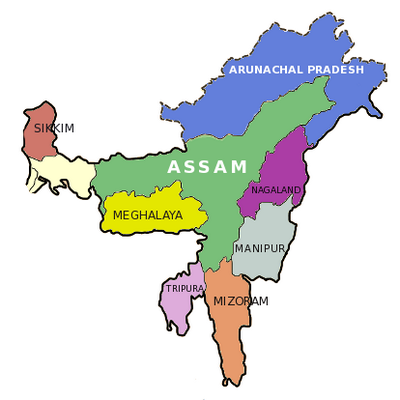
Source: The Indian Wire.
I, too come from the Northeast, and it has disconcerted me a few times that many people I met in Korea were initially taken aback by my Indian origin. Some have exclaimed that I am an ‘un-Indian’ looking Indian. These notions of nationality corresponding to race, are possibly reinforced by Hollywood’s stereotypical portrayal of Indians as people with dark skin and big eyes. In reality, India is a multicultural country and transcends this caricature with much more to offer.
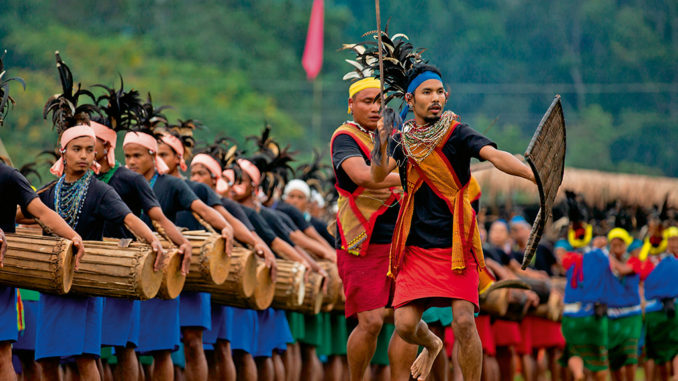
Garo tribe of Meghalaya gathering for 100 Drums Wangala Festival. Photo by Shalini Shiva Prasad via natgeotraveller.
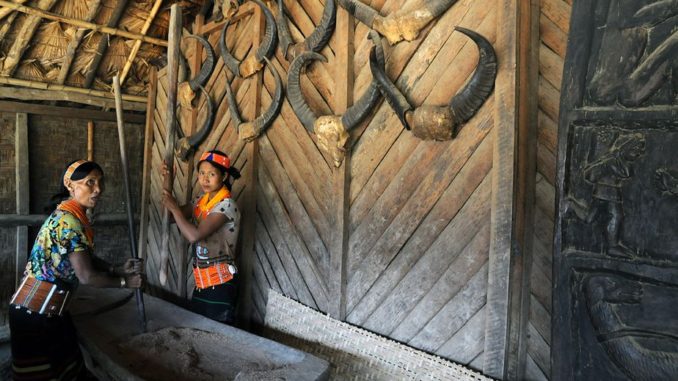
Konyak Women grinding rice, Nagaland. Photo by Sugato Mukherjee via The Diplomat.
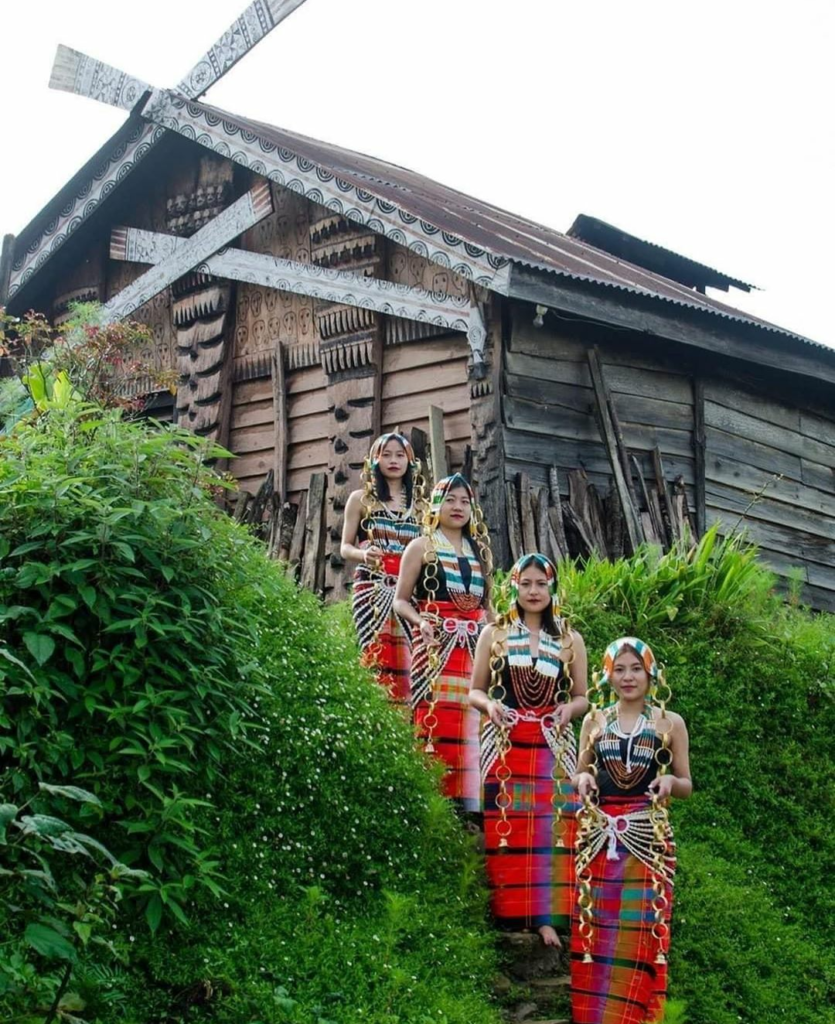
The Tangkhul Tribe, Manipur.
Why don’t people know about India’s Northeast?
It is true that the Northeast is only connected by a thin strip of land to the rest of India and this geographical separation can make many unaware of its existence, but a large part of this ignorance owes to India’s failure in bringing the Northeast into its narrative. The India that is portrayed, is the majoritan culture which is assumed to be pan-Indian or national. Bollywood, India’s film industry which takes Indian culture to the world has no representation of the Northeast, whether of the place or its people. Thus, in India’s imagined community, the Northeast is pushed to the periphery and often cast into the shadows and silence, like a child out of wedlock that India wants to hide because of its strangeness compared to the rest of India. What is remarkable is that Indians themselves, are ignorant about the Northeastern people and treat them as foreigners and often, many Indians are heard saying ‘they are not like us.’ Consequently, cases of racism against the Northeastern people are rampant.
This year, the Covid-19 situation compounded the racist attacks on the Northeastern people. Many were evicted out of their homes, called ‘Coronavirus’ or Corona, assaulted and told to go to China, or denied entry into markets. There were two incidents, one in Mumbai and another in Delhi – both India’s leading cities, where a girl was spat at and called Corona. These are certainly not isolated events as many incidents go unreported because of fear, lack of help and support from authorities.
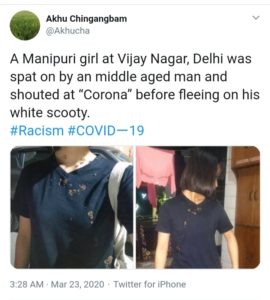
It is an irony that a lot of Indians and celebrities were joining the bandwagon on Black Lives Matter while there was deafening silence during the pandemic when the Northeastern people were being treated as a disease and all sorts of atrocities were meted out to them. The support for BLM is in itself not problematic but the double-standards when it comes to racism at home is flabbergasting.
In the past, there have been numerous assaults on the Northeastern people simply for looking different. In 2012, it was Richard Loitam from Manipur and 2 years later, a youth from Arunachal Pradesh Nido Taniam was killed for just the colour of his hair. There are many cases of rape, while ‘eve teasing’ (which is verbal harassment of women using sexual comments) is an ordeal that the Northeastern women frequently face in the streets. The women are stereotyped as ‘loose’ and ‘easy’ or seen as exotic beauties to be showcased. Being called ‘chinky’, ‘chowmein’, or ‘Chinese’ is so common that it is not surprising anymore. Many are discriminated at entrances into historical monuments, often being made to pay higher entry fees than what Indian citizens are required to. In 2012, the police also arrested many Northeastern youth, refusing to listen to their assertions of being Indian, as they suspected them to be Tibetans who were protesting the visit of one Chinese official on the basis of their similar looks. Clearly, very little is done to rectify and address such gaps.
A dichotomy exists between the rest of India, referred to as the ‘mainland’ and the Northeast because of this deep divide. Time and again people from the Northeast have to prove their ‘Indianness’. One of the ways they are expected to do so is to learn Hindi, an unjustified imposition in a country which has 22 official languages (excluding English) with no national language.
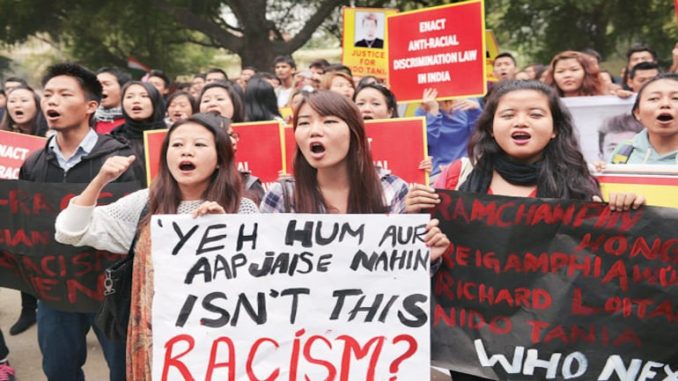
Northeast students demanding justice for Nido Taniam. Photo via India Today.
Why are the Northeastern people alienated in their own country?
The reason can be located historically. Prior to the British colonial rule in India, the Northeastern region consisted of different independent warring tribes and, except for some parts of present-day Assam, was never a part of any dynasty or empire that ruled India. It was the British who annexed these ‘tribal’ chiefdoms one by one during the 19th century, integrating them for the first time into what was colonial India at that time. Consequently, in post-Independence India, there was tension between the Northeast and the Indian state and violence was a major part of the nation-building process to retain the Northeast as Indian territory. India has hardly ever seen the Northeast as part of it, except for geo-political and strategic matters as a frontier region. Not only that, the Northeast is seen as having contributed very little to the national consciousness and the freedom struggle against colonialism. Therefore, there is systematic exclusion of the history of the Northeast in school curriculums, as its history is perceived as detached from the glories of India’s past kingdoms or the legacy of the Indian Independence movement. Due to this neglect, even educated Indians are not aware of the Northeast’s geography, sometimes grossly mistaking the Northeast states and their capitals to be located outside of India.
The Indian Government over the years has rarely made efforts to sensitize its citizens to the Northeastern community even as scores of them migrate to cities in other parts of the country for education, job and better lives. Another evidence of this neglect is the absence of the Northeast in national news. Until recent piecemeal inclusions, media channels hardly featured news on the Northeast. Severe natural disasters were conveniently ignored or under-reported, and recently, an article on Scroll.in, an Indian online news media also brought to light this issue. They criticized the failure of livemint (another digital news media) to include books by Northeastern writers in their ‘A Lounge guide to India in 50 books,’ published in commemoration of India’s Independence. This is nothing but erasure of the Northeast literary culture, rich as they are, from the mainstream literature. That the Northeast is treated as a periphery is no secret.
Bollywood with its wide domestic appeal, could help to mitigate the effects of racism and to sensitize people on the issue, but with its hackneyed themes of family drama and love affairs, there is overwhelming neglect of the Northeast in its storytelling. The few times that movies included the region (e,g Dil Se 1998, Tango Charlie 2005 etc), it juxtaposed the Northeast as areas of insurgency and violence vis-a-vis the stable Indian state, while simultaneously positing the Northeast as the ‘other’. Moreover, when it made a biopic in 2014, on the world-renowned boxer from Manipur, Mary Kom, much to the chagrin of many Northeastern people, a North-Indian actress, Priyanka Chopra who is not representative of Northeastern looks, was cast to play the role in order to ensure box-office success.
A lot of times, movies on the Northeast are local productions. A comedic satirical movie titled ‘Axone’, the first in history to exclusively deal with racism against the Northeastern people, was directed by Nicholas Kharkongkor, who is himself from the Northeast. The movie makes aware the grievances of what the Northeast people have had to bear with in India’s metropolitan cities. Revolving around finding a safe space to cook ‘Axone’, a fermented delicacy of the Naga people, the movie brilliantly highlights the different faces of racism encountered daily by the people of Northeast.
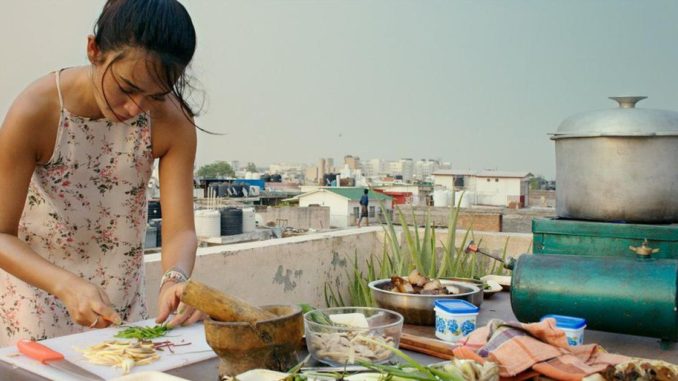
Sayani Gupta preparing Axone Pork (Yoodlee films), Photo via Scroll.in.
However, there seems to be an anti-climax within the film, a capitulation to the conventional narrative, that the Northeastern people need to be more assimilative and that they have the tendency to be aloof, i.e mingling more within their own community. The onus thus, is shifted to the Northeastern people themselves as responsible for the racism by their own aloofness, without reminding the viewers that ‘aloofness’ is in fact reinforced by the othering. Nonetheless, the rationale of minimal interactions of the Northeastern people with the ‘mainland’ does not justify nor vindicate the racist attacks on them. Or perhaps the director’s intention is to show that the Northeastern people themselves have internalized the narrative of assimilation. Whatever the director’s intentions were, the movie seems to poignantly remind us that the Northeastern people will continue to be seen as misfits in the Indian society.
73 years have passed since India’s independence. It is high time that the rest of India stop questioning the ‘Indianness’ of the Northeastern people and instead accept them, different as they are. Assimilation to the majority does not prove their Indianness but only strips them of their uniqueness, and India of its diversity. Attempts of assimilation also only leads to further alienation. There are many Indians who may not perpetuate racism overtly, but the presently heightened communal atmosphere in the country does not portend well for India’s minorities. I hope the ‘mainland’ Indians could consider these words of Jeane Paul Sartre: “Every word has consequences. Every silence, too.” And this applies not just to the issue of racism against the Northeastern people but to caste atrocities on Dalits too.
There is a lot of awareness about Caste oppression within India as well as internationally, but in comparison, awareness about the plight of the Northeastern people is lacking. There certainly needs to be more focus on the issue of racism against the Northeastern people. I hope this article adds a bit more perspective for international readers to reflect on their ideas of India, and manages to break some of their preconceived notions. It will be good to keep in mind that India is not home to a single race!
- Race Against Time: South Korea’s Role in Mitigating Climate Change - September 8, 2021
- Countering Oppressive Ideologies: Reasons Why India Cannot Write off Liberal Arts and the Social Sciences - July 21, 2021
- Is there a Silver Lining in the Plight of Multi-Ethnic Children Against Bullying in Korea? - May 7, 2021

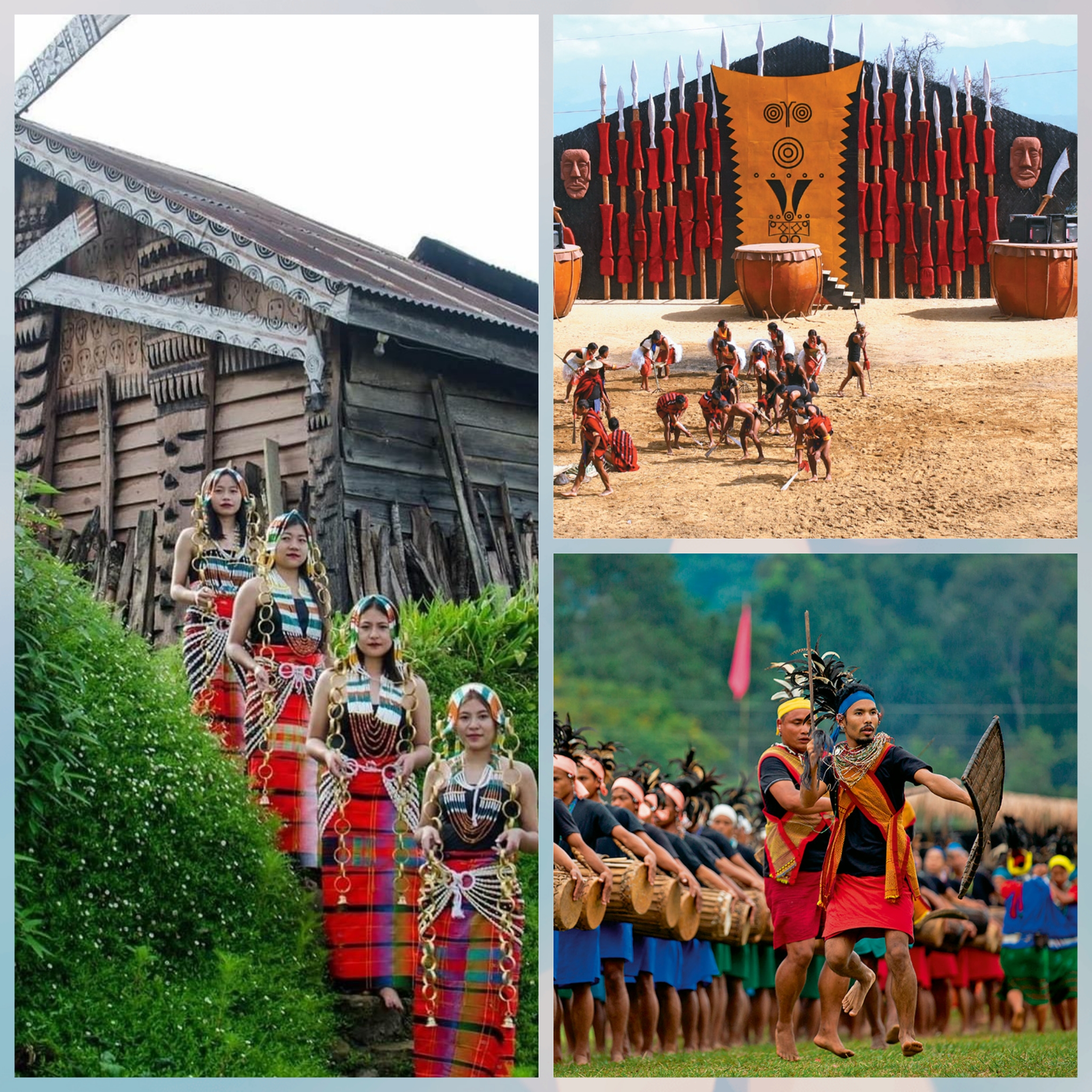

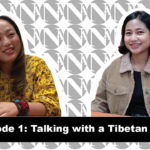

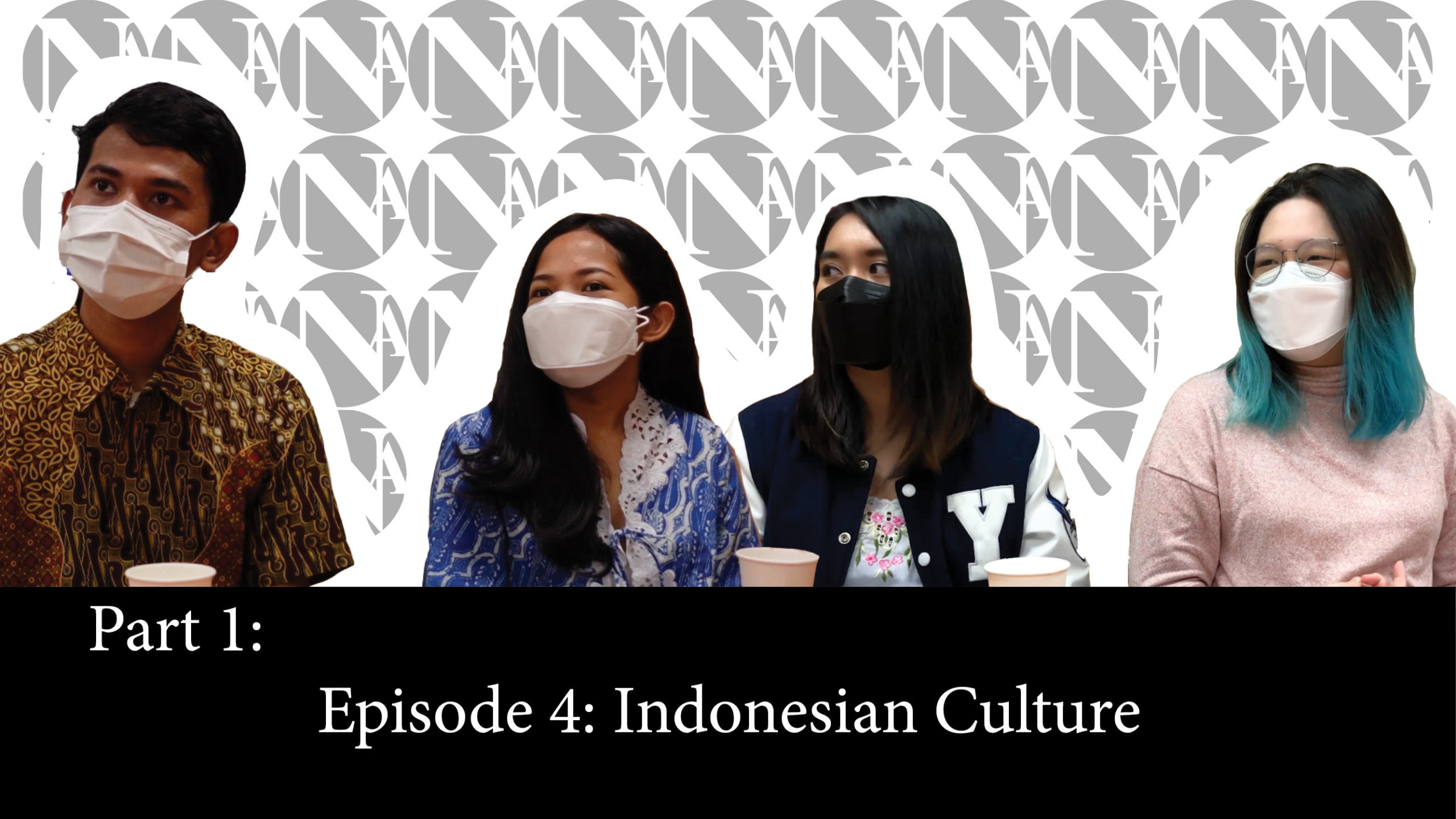
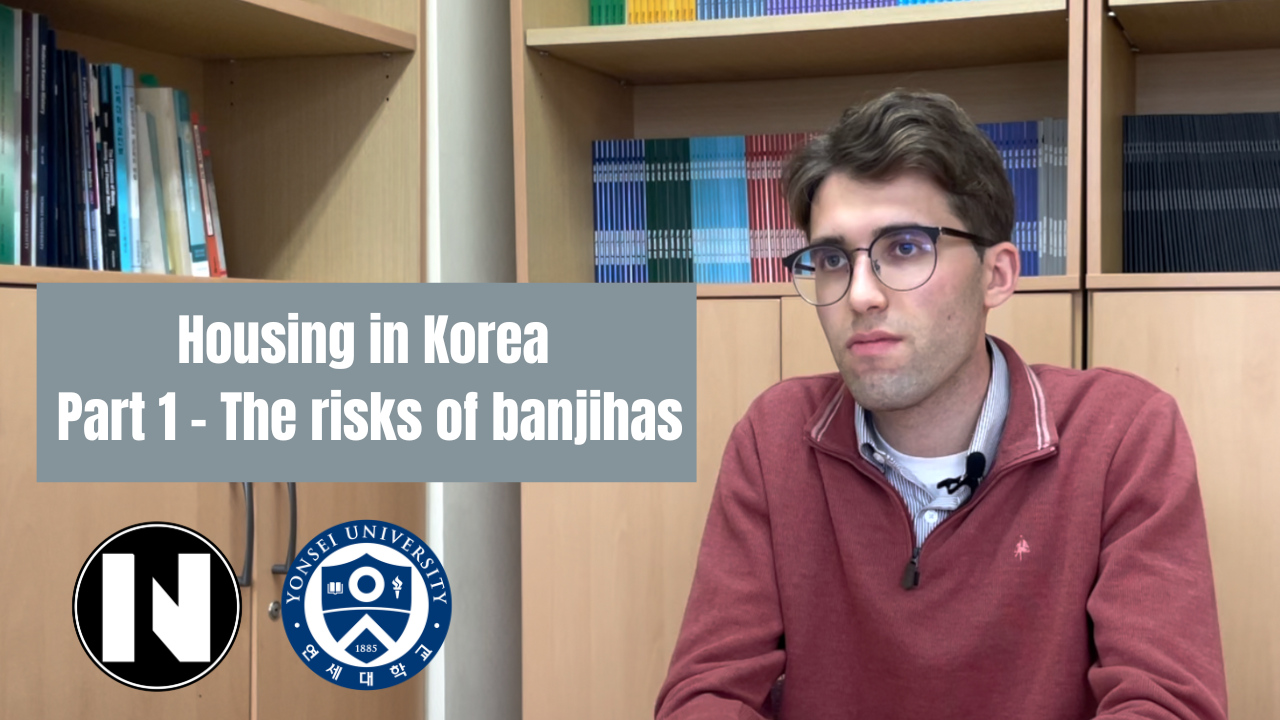
1 Comment
P. T. Sangma
4 years agoI’m proud of you, my dearest Cherian that you brought forward the attacks on racist mostly on North East people and I hope it’ll come to the knowledge of the present BJP government and compensate the neglected States..
Comments are closed.